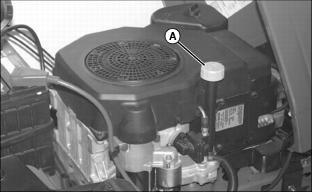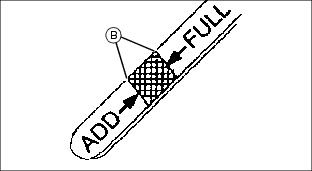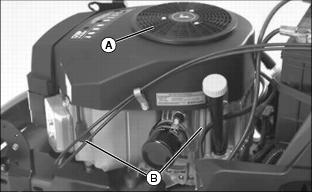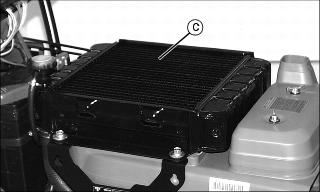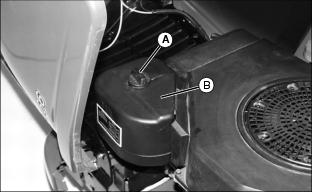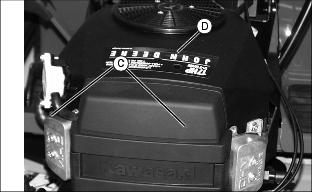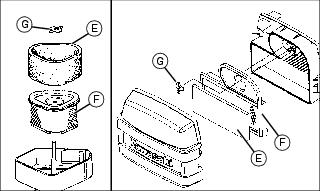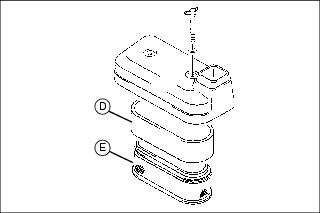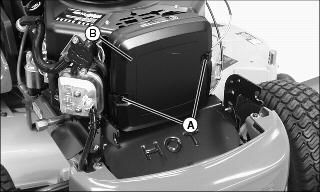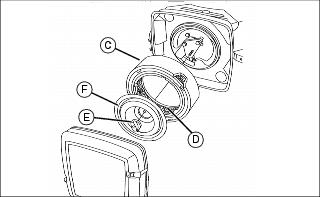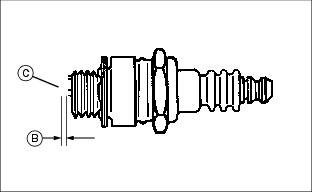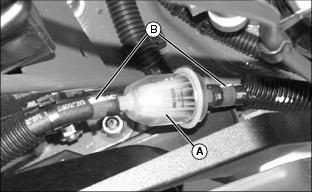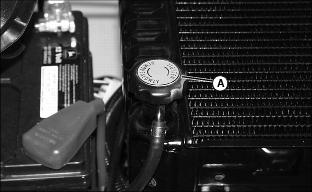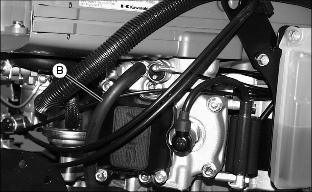LX266, LX277, LX277AWS, LX279 and LX288
Introduction
Product Identification
Safety
Operating
Replacement Parts
Service Intervals
Service Lubrication
Service Engine
Engine Warranty Maintenance Statement
Changing Engine Oil and Filter
Cleaning Air Intake Screen and Engine Fins
Servicing Air Cleaner (LX266, LX277 and LX277AWS)
Checking Coolant Level (LX279)
Service Transmission
Service Mower - Freedom42
Service Mower - 42C, 48C, 54C
Service Electrical
Service Miscellaneous
Troubleshooting
Storage
Assembly
Specifications
Warranty
John Deere Quality Statement
Service Record

Service Engine
Engine Warranty Maintenance Statement
Maintenance, repair, or replacement of the emission control devices and systems on this engine, which are being done at the customers expense, may be performed by any non-road engine repair establishment or individual. Warranty repairs must be performed by an authorized John Deere dealer.
Avoid Fumes
Engine Oil
Use oil viscosity based on the expected air temperature range during the period between oil changes.
The following John Deere oils are preferred:
Other oils may be used if above John Deere oils are not available, provided they meet the following specification:
· API Service Classification SG or higher
Checking Engine Oil Level
NOTE: Check oil twice a day if you run engine over 4 hours in a day.
Make sure engine is cold when checking engine oil level.
1. Park machine safely. (See Parking Safely in the SAFETY section.)
3. Clean area around dipstick (A) to prevent debris from falling into crankcase.
4. Remove dipstick. Wipe with clean cloth.
· LX266, LX277, LX277AWS and LX279 - Install dipstick in tube but do not tighten. Allow dipstick threads to rest on top of tube and rotate cap counterclockwise until it "clicks" or drops into place.
· LX288 - Install and tighten dipstick.
7. Check oil level on dipstick. Oil must be between ADD and FULL marks (B).
8. If oil level is low, add oil to bring oil level no higher than FULL mark on dipstick.
9. Install and tighten dipstick. Lower hood.
Changing Engine Oil and Filter
2. Park machine safely on level surface. (See Parking Safely in the SAFETY section.)
4. Put drain pan under drain valve (A). If available, install drain hose.
5. Open drain valve and drain oil into oil drain pan. Allow oil to drain completely.
a. Wipe dirt from around oil filter (C).
b. Place a drain pan or funnel under filter tray.
c. Remove old filter and wipe off filter tray.
d. Apply a light coat of fresh oil to filter seal.
e. Install replacement oil filter by turning oil filter to the right (clockwise) until rubber seal contacts filter base. Tighten filter an additional one-half turn.
· LX266, LX277, LX277AWS and LX279: 1.8 L (1.9 qt)
10. Install and tighten dipstick.
11. Start and run engine at idle to check for leaks. Stop engine. Fix any leaks before operating.
12. Check oil level, add oil if necessary.
Cleaning Air Intake Screen and Engine Fins
IMPORTANT: Avoid damage! The engine requires a large amount of air intake when running. Reduced air intake can cause overheating: |
1. Park machine safely. (See Parking Safely in the SAFETY section.)
2. Clean air intake screen (A), cooling fins, and external surfaces (B), with rag, brush, vacuum or compressed air.
3. LX279 Only - When operating in extremely dirty conditions, remove air intake screen and clean radiator screen (C).
Servicing Air Cleaner (LX266, LX277 and LX277AWS)
1. Park machine safely. (See Parking Safely in the SAFETY section.)
3. Raise or remove hood as needed to access air cleaner.
· LX266 - Loosen knob (A) and remove cover (B).
· LX277 and LX277AWS - Release latches (C) and remove cover (D).
Picture Note: LX266 shown left, LX277 and LX277AWS shown right.
5. Inspect foam precleaner (E) without removing it. If precleaner is dirty:
a. Remove precleaner carefully without removing paper element (F).
b. Wash it in a solution of warm water and liquid detergent. Rinse, squeeze out excess water in a dry cloth, and allow to air dry.
c. Add approximately 30 ml (1 oz) of clean engine oil to precleaner. Squeeze precleaner to distribute oil evenly.
6. Inspect paper element (F) without removing it. If element is damaged or very dirty:
b. Remove paper element carefully from air cleaner housing. Discard the element.
c. Clean the air cleaner housing carefully to prevent dirt from entering the carburetor.
d. Install new paper element into air cleaner. Make sure element is seated properly.
7. Install precleaner on paper element.
8. Install air cleaner cover. Do not overtighten.
Servicing Air Cleaner (LX279)
1. Park machine safely. (See Parking Safely in the SAFETY section.)
4. Remove air intake screen (A):
5. Remove thumb screws and washers (B) and cover (C).
6. Inspect foam precleaner (D) without removing it. If precleaner is dirty:
a. Remove precleaner carefully without removing paper element (E).
b. Wash it in a solution of warm water and liquid detergent. Rinse, squeeze out excess water in a dry cloth, and allow to air dry.
c. Add approximately 30 ml (1 oz) of clean engine oil to precleaner. Squeeze precleaner to distribute oil evenly.
7. Inspect paper element (E) without removing it. If element is damaged or very dirty:
a. Remove paper element carefully from air cleaner housing. Discard the element.
b. Clean the air cleaner housing carefully to prevent dirt from entering the carburetor.
c. Install new paper element into air cleaner. Make sure element is seated properly.
8. Install precleaner on paper element.
9. Install air cleaner cover. Do not overtighten.
Servicing Air Cleaner (LX288)
1. Park machine safely. (See Parking Safely in the SAFETY section.)
4. Release latches (A) and remove cover (B).
5. Inspect foam precleaner (C) without removing it. If precleaner is dirty:
a. Remove precleaner carefully without removing paper element (D).
b. Wash it in a solution of warm water and liquid detergent. Rinse, squeeze out excess water in a dry cloth, and allow to air dry.
c. Add approximately 30 ml (1 oz) of clean engine oil to precleaner. Squeeze precleaner to distribute oil evenly.
6. Inspect paper element (D) without removing it. If element is damaged or very dirty:
a. Remove knob (E) and plate (F).
b. Remove paper element carefully from air cleaner housing. Discard the element.
c. Clean the air cleaner housing carefully to prevent dirt from entering the carburetor.
d. Install new paper element into air cleaner. Make sure element is seated properly.
e. Install plate and secure with knob.
7. Install precleaner on paper element.
8. Install and latch the air cleaner cover.
Checking Spark Plugs
1. Park machine safely. (See Parking Safely in the SAFETY section.)
4. Disconnect spark plug wire(s) (A).
6. Clean each spark plug carefully with a wire brush.
· Pitted or damaged electrodes.
NOTE: In Canada, replace spark plug with resistor plug only.
8. Replace spark plugs as necessary.
9. Check plug gap (B) with a wire feeler gauge. To change gap, bend outer electrode (C).
· LX266, LX277, LX277AWS - Gap must be 1.00 mm (0.040 in.).
· LX279 - Gap must be 0.70 mm (0.028 in.).
· LX288 - Gap must be 0.76 mm (0.030 in.).
10. Install and tighten spark plugs:
· LX277, LX277AWS - 15 N·m (133 lb-in.).
· LX279 - 17 N·m (150 lb-in.).
· LX288 - 20 N·m (177 lb-in.).
Adjusting Carburetor
NOTE: Carburetor is calibrated by the engine manufacturer and is not adjustable.
If engine is operated at altitudes above 1829 m (6,000 ft), some carburetors may require a special high altitude main jet. See your John Deere dealer.
If engine is hard to start or runs rough, check the troubleshooting section of this manual.
Possible engine surging will occur at high throttle with transmission in "N" neutral and mower engagement lever disengaged. This is a normal condition due to the emission control system.
After performing the checks in the troubleshooting section and your engine is still not performing correctly, contact your John Deere dealer.
Replacing Fuel Filter
NOTE: Change filter when fuel is low to prevent excessive fuel spillage.
1. Park machine safely. (See Parking Safely in the SAFETY section.)
4. Place a drain pan under fuel filter (A).
5. Note direction of arrow on fuel filter so new filter can be installed in the same direction.
6. Use a pliers to slide hose clamps (B) away from fuel filter.
7. Disconnect hoses from filter.
IMPORTANT: Avoid damage! Incorrect installation of fuel filter may cause engine damage. Install the filter with the arrow pointing in the direction of fuel flow for proper operation. |
8. Make sure arrow on new filter is pointing in the direction of fuel flow. Connect hoses to filter.
9. Slide hose clamps in position to secure filter.
Recommended Engine Coolant
The following John Deere coolant is preferred:
· COOL-GARD PRE-DILUTED SUMMER COOLANT (TY16036).
· COOL-GARD CONCENTRATED SUMMER COOLANT (TY16034)
If neither of the above coolants is available, use an ethylene glycol base coolant that meets the following specification:
Check container label before using to be sure it has the appropriate specifications for your machine. Use coolant with conditioner or add conditioner to coolant before using.
If using concentrate, mix approximately 50 percent antifreeze with 50 percent distilled or deionized water before adding to cooling system. This mixture will provide freeze protection to -37 degrees C (-34 degrees F).
Certain geographical areas may require lower temperature protection. See the label on your antifreeze container or consult your John Deere dealer to obtain the latest information and recommendations.
Checking Coolant Level (LX279)
1. Park machine safely on a level surface. (See Parking Safely in the SAFETY section.)
· If engine is hot, coolant should be up to "H" mark (A) on recovery tank.
· If engine is cold, coolant should be at "L" mark (B) on recovery tank.
4. Remove cap (C) from recovery tank if coolant is low. Add ethylene glycol antifreeze (without stop-leak additive) and water in a 50:50 ratio to bring coolant up to proper level.
5. Install and tighten recovery tank cap.
6. Clean debris from air intake screens and radiator.
7. Check condition of hoses. Check for leaks or loose connections.
Servicing Cooling System
Draining Cooling System
1. Park machine safely on a level surface. (See Parking Safely in the SAFETY section.)
4. Loosen and remove radiator cap (A) slowly to release all pressure, then tighten cap.
5. Locate hose (B) between water pump and cylinder head on left side of engine. Loosen upper hose clamp with pliers.
6. Position a bucket below the hose.
7. Remove hose from fitting on cylinder head. Drain all coolant into bucket.
NOTE: If pressure has been released from radiator and cap is tight, only a small amount of coolant should escape from cylinder head.
8. Install hose and clamp to cylinder head fitting after coolant has drained completely.
Flushing Cooling System
2. Fill cooling system with clean water and John Deere Cooling System Cleaner, or John Deere Cooling System Quick Flush or an equivalent. Follow directions on the can.
3. Install and tighten radiator cap.
4. Start and run engine until it reaches operating temperature.
6. Drain cooling system immediately before rust and dirt settle.
Filling Cooling System
3. Fill cooling system. Coolant capacity is 2.6 L (2.8 qt).
4. Install and tighten radiator cap.
5. Run engine until it reaches operating temperature.
7. Check coolant level while engine is hot and after cooling to ensure proper level in recovery tank. If necessary, fill recovery tank to proper level.


